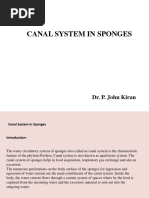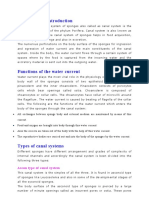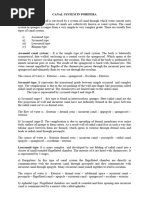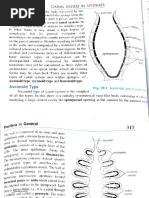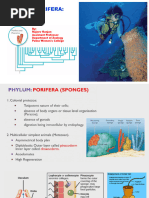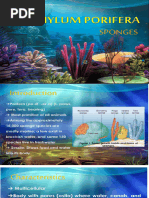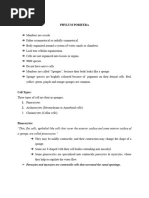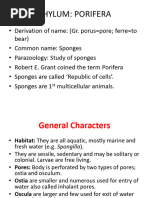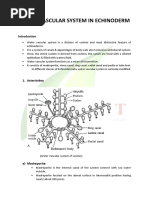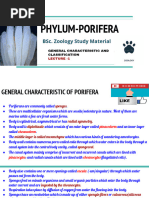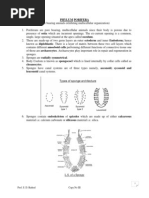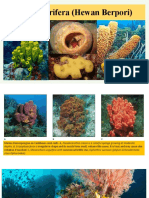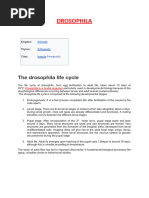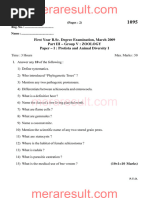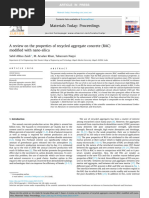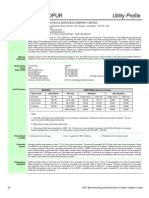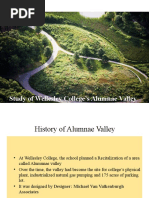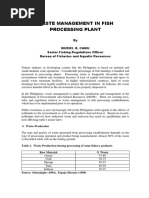Canal
Canal
Uploaded by
lavanyaluv252Copyright:
Available Formats
Canal
Canal
Uploaded by
lavanyaluv252Copyright
Available Formats
Share this document
Did you find this document useful?
Is this content inappropriate?
Copyright:
Available Formats
Canal
Canal
Uploaded by
lavanyaluv252Copyright:
Available Formats
Canal System in Sponges:
The body wall of the sponges is folded to produce a complex system of pores and canals
for the entrance of water current. Depending upon the arrangement of these canals in sponges, the
canal system is of many types. But, there are usually four types of canal system met within
sponges, they are,
• Asconoid type
• Syconoid type
• Leuconoid type.
• Rhagon type
1.Asconoid Type
Asconoid type of canal system is the simplest of all the types. In this there is a radially
symmetrical vase-like body consisting of a thin wall enclosing a large central cavity the
spongocoel opening at the summit by the narrowed osculum.
The wall is composed of an outer and inner epithelium with a mesenchyme between. The
outer or dermal epithelium here termed epidermis consists of a single layer of flat cells. The inner
epithelium, lining the spongocoel, is composed of choanocytes. The mesenchyme contains
skeletal spicules and several types of amoebocytes, all embedded in a gelatinous matrix.
The wall of the asconoid sponge is perforated by numerous microscopic apertures termed
incurrent pores or ostia which extend from the external surface to the spongocoel. Eachpore is
intracellular, i.e., it is a canal through a tubular cell called a porocyte.
Asconoid type of canal system-Eg -Leucosolenia
The water current impelled by the flagella of the choanocytes passes through the
incurrent pores into the spongocoel and out through the osculum.Furnishing in its passage food
and oxygen and carrying away metabolic wastes. Asconoid type of canal system is found only in
few sponges, e.g., Olynthus, Leucosolenia.
The course of water current
water from exterior → incurrent pores → spongocoel → osculum → water out
According to Hyman, the important features of the asconoid structure are the simple wall
and the complete continuous lining epithelium of choanocytes, interrupted only by the inner ends
of the porocytes. The asconoid type of sponge superficially resembles a typical gastrula.
2. Syconoid Type:
Syconoid type of canal system is the first stage above the asconoid type. It is formed by
the out-pushing of the wall of an asconoid sponge at regular intervals into finger-like projections,
called radial canals.
At first these radial canals are free projections and the outside water surrounds their
whole length, for there are no definite incurrent channels. But in most syconoid sponges, the
walls of the radial canals fuse in such a manner as to leave between them tubular spaces, the
incurrent canals, which open to the exterior between the blind outer ends of the radial canals by
apertures termed dermal ostia or dermal pores.
Syconoid type of canal system (Early stage without cortex)
Since these incurrent canals represent the original outer surface of the asconoid sponge,
they are necessarily lined by epidermis. Radial canals being the outpushings of the original
spongocoel are necessarily lined by choanocytes and are, therefore, better called flagellated
canals.
The interior of the syconoid sponge is hollow and forms a large spongocoel which is
lined by the flat epithelium derived from epidermis. The openings of the radial canals into the
spongocoel are termed internal ostia. The syconoid sponges retain the radial vase form of the
asconoids and the spongocoel opens to the exterior by the single terminal osculum.
The wall between the incurrent and the radial canals, is pierced by numerous minute
pores called prosopyles.
The water current in syconoid sponges takes the following route
Dermal pores → incurrent canals → prosopyles → radial canals → internal ostia
(apopyles) → spongocoeL → osculum → out
The syconoid sponges differ from the asconoid type in two important particulars:
(i) In the thick folded walls containing alternating incurrent and radial canals and
(ii) In the breaking of the choanocyte layer, which no longer lines the whole interior but
is limited to certain definite chambers (radial canals).
Final syconoid canal system (with cortex)
The syconoid structure occurs in two main stages. The first type illustrated in a few of the
heterocoelous calcareous sponges, especially members of the genus Sycon. In the second stage,
the epidermis and mesenchyme spread over the outer surface forming a thin or thick cortex often
containing special cortical spicules. The epidermis becomes pierced by more definite pores than
lead into narrowed incurrent canals.
3. Leuconoid Type:
As a result of further process of out folding of the choanocyte layer and thickening of
body wall, the leuconoid type of canal system develops. The choanocyte layer of the radial canal
of the syconoid stage evaginates into many small chambers, and these may repeat the process, so
that clusters of small rounded or oval flagellated chambers replace the elongated chambers of the
syconoid stage.
The choanocytes are limited to these chambers. Mesenchyme fills in the spaces around
the flagellated chambers. The spongocoel is usually obliterated and the whole sponge becomes
irregular in structure and indefinite in form. The interior of the sponge becomes permeated by
many incurrent and ex-current canals join to form larger ex-current canals and spaces which lead
to the oscula.The surface is covered with epidermal epithelium and is pierced by many dermal
pores (ostia) and oscula.
The dermal pores lead into incurrent canals that branch irregularly through the
mesenchyme. The incurrent canals lead into the small rounded flagellated chambers by opening
still termed prosopyles. The flagellated chambers open by apertures called apopyles into ex-
current channels, and these unite to form larger and larger tubes, of which the largest lead to the
oscula.
Leuconoid type of canal system with eurypylous chambers
The main characteristics of the leuconoid type of canal system are the limitation of the
choanocytes to small chambers, the great development of the mesenchyme, and the complexity of
the incurrent and excurrent canals.
The course of water current
Dermal ostia → incurrent canals → prosodus (if present) → prosopyles → flagellated
chambers → apopyles → aphodus (if present) → excurrent canals → larger channels → oscula
→ out
The leucon type of canal system is very efficient and most sponges are built on the
leuconoid plan and they attain a considerable size.
They are always irregular in structure but the flow of the current of the water is fairly
rapid and efficient. The leuconoid type of canal system exhibits numerous variations but presents
three stages of evolution, viz., eurypylous, aphodal, and diplodal.
Leuconoid type of canal system Leuconoid type of canal system With
With aphodal chambers diplodal chambers
(a) Eurypylous:
In the eurypylous leuconoid type of canal system, the flagellated chambers are wide and
thimble-shaped, each opening directly into the excurrent canal by a wide aperture called apopyle
and receive the water supply direct from the incurrent canal through the prosopyle.
The current of water takes the following route
Dermal pores or ostia → subdermal spaces → incurrent canals → prosopyles →
flagellated chambers → apopyles —> excurrent canals spongocoel → oscula → out
This type of canal system is found in Leucilla.
(b) Aphodal:
In the aphodal leuconoid type of canal system, the flagellated chambers are small and
rounded. The opening of each flagellated chamber into the excurrent canal is drawn out into a
narrow tube, usually not of great length, termed aphodus. The relation of the flagellated chambers
to the incurrent canals remain as before.
The route of water current is as follows
Dermal pores or ostia → subdermal space → incurrent canals → prosopyles →
flagellated chambers → aphodus → excurrent canals→ spongocoel → oscula → out
This type of canal system is found in Geodia and Stelleta.
(c) Diplodal:
In some cases there is also a narrow current tube, the prosodus between the incurrent
canal and the flagellated chambers, such a condition is called diplodal. This type of canal system
is found in Oscarella, Spongilla, etc.
The current of water takes the following route:
Dermal pores or ostia → subdermal spaces → incurrent canals → prosodus → flagellated
chambers → aphodus → excurrent canals → spongocoel → oscula → out.
4.Rhagon
In calcareous sponges, the leuconoid structure may be attained by way of asconoid and
syconoid stages. But in Demospongiae it is derived from a stage termed a rhagon which in turn
arises by direct rearrangement of the inner cell mass.
Rhagon larva V.S showing rhagon type of canal system
The rhagon type of sponge has a broad base and it is conical in shape with a single
osculum at the summit. The basal wall is termed the hypophare which is devoid of flagellated
chambers. The upper wall bearing a row of small, oval flagellated chambers is called
spongophare.
Spongocoel is bordered by oval flagellated chambers opening into it by wide apopyles.
Between the chambers and the epidermis lies a considerable thickness of mesenchyme traversed
by incurrent canals and subdermal spaces. Dermal pores or ostia open into sub-dermal spaces
which extend below the entire surface of the body.Eg-spongilla
Spongilla
Spongilla –Diagrammatic vertical section showing rhagon type of canal system
Branching incurrent canals lead from the sub-dermal spaces into small flagellated
chambers which have been formed by breaking down of radial canal, the flagellated chambers
alone are lined by choanocytes. From the flagellated chambers ex-current canals lead into a
spongocoel.
The incurrent and ex-current canals may be complex and branched. The spongocoel
opens by a single osculum.
The course of current of water is
Ostia→ sub-dermal spaces → incurrent canals → prosopyles → flagellated chambers →
apopyles → ex-current canals → spongocoel → osculum → out.
Functions of Canal System:
The canal system helps the sponges in nutrition, respiration, excretion and reproduction.
The current of water which flows through the canal system brings the food and oxygen and takes
away the carbon dioxide, nitrogenous wastes and faeces.
It carries the sperms from one sponge to another for fertilisation of the ova. The canal
system also increases the surface area of the sponges in contact with the water and, thus, enables
the sponges to increase their volume as surface volume ratio must remain fixed.
REFERENCE BOOKS:
1. Dr.Veer Bala Rastogi
2. E.L.Jordan
3. P.S.Verma
You might also like
- HSE Infographic Annual ReportDocument11 pagesHSE Infographic Annual Reportthinkpad100% (3)
- Ujjain CDP - FinalDocument408 pagesUjjain CDP - FinalRaghav GuptaNo ratings yet
- BSC Part I Canal System in PoriferaDocument6 pagesBSC Part I Canal System in PoriferaSriram MNo ratings yet
- Porifera-Canal SystemDocument11 pagesPorifera-Canal SystemCutest guddyNo ratings yet
- Canal System in PoriferaDocument6 pagesCanal System in Poriferasakibsharief911No ratings yet
- Porifera Canal SystemDocument6 pagesPorifera Canal Systemshauryasingh1552No ratings yet
- Zoology Project of ZrsaDocument4 pagesZoology Project of ZrsaZotei RawihteNo ratings yet
- CANAL SYSTEM IN SPONGES - pdf289Document14 pagesCANAL SYSTEM IN SPONGES - pdf289suju2127No ratings yet
- Wanater Canal System of SpongesDocument6 pagesWanater Canal System of SpongesAakash VNo ratings yet
- SpongesDocument16 pagesSpongesKazuki Fuchoin100% (1)
- PoriferaDocument2 pagesPoriferaAvneetian creationNo ratings yet
- CANAL SYSTEM IN SPONGES BY AASIYADocument10 pagesCANAL SYSTEM IN SPONGES BY AASIYAfadeenk9No ratings yet
- Canal SystemDocument5 pagesCanal Systemsvjshorts07No ratings yet
- PoriferaDocument33 pagesPoriferaRushikesh pawar100% (1)
- PoriferaDocument10 pagesPoriferanh2grq69r2No ratings yet
- Canal SystemDocument9 pagesCanal Systemjagjit kumarNo ratings yet
- Multicellular and Tissue Level OrganizationDocument9 pagesMulticellular and Tissue Level OrganizationHAIDER ALI PRODUCTIONNo ratings yet
- 2024810153445746_37685Phylum PoriferaDocument17 pages2024810153445746_37685Phylum PoriferaranjanshubhanginiNo ratings yet
- 55 16saczo1 2020121910192848Document30 pages55 16saczo1 2020121910192848Dandy H HerkoNo ratings yet
- Clss and GCDocument39 pagesClss and GCsanskritisingh4321No ratings yet
- Canal System in PoriferaDocument7 pagesCanal System in Poriferamd3618759No ratings yet
- SyconDocument11 pagesSycondurgavarshini247No ratings yet
- 4 PoriferaDocument11 pages4 PoriferadianoktaNo ratings yet
- Phylum Porifera - SpongesDocument11 pagesPhylum Porifera - SpongesArief Hidayat Handytalky GarutNo ratings yet
- PoriferaDocument14 pagesPoriferaNazwa AuliaNo ratings yet
- DS - Zoology - Phylum Porifera - Sem1Document11 pagesDS - Zoology - Phylum Porifera - Sem1Mohamed SelemanNo ratings yet
- Porifera ReviewerDocument8 pagesPorifera ReviewerCarlo MendozaNo ratings yet
- Phylum - Porifera-2308Document45 pagesPhylum - Porifera-2308shaikhaman0674No ratings yet
- PoriferaDocument3 pagesPoriferaDave RapaconNo ratings yet
- HRCCZoo TS Int To ParaZoaGenCharacteristis 20221220Document45 pagesHRCCZoo TS Int To ParaZoaGenCharacteristis 20221220D4R7H W4D3RNo ratings yet
- Lecture 6 MulticellularOrganizationDocument28 pagesLecture 6 MulticellularOrganizationshahbaz zafarNo ratings yet
- Phylum PoriferaDocument7 pagesPhylum PoriferaLaraib Fatima Al HussainiNo ratings yet
- PHYLUM PoriferaDocument13 pagesPHYLUM Poriferanirajbaniya757No ratings yet
- Asymmetrical Body: Pores: Ostia Osculum: Canal System: Main Types of Canal System. Asconoid - Syconoid: Leuconoid: - Spongocoel.Document1 pageAsymmetrical Body: Pores: Ostia Osculum: Canal System: Main Types of Canal System. Asconoid - Syconoid: Leuconoid: - Spongocoel.dorcaschepkoech525No ratings yet
- Phylum PoriferaDocument12 pagesPhylum Poriferajoel blaya100% (1)
- Water Vascular System in EchiondermDocument6 pagesWater Vascular System in Echiondermapi-481318101100% (2)
- Phylum PoriferaDocument8 pagesPhylum Porifera21400744No ratings yet
- Labporifera 2012Document8 pagesLabporifera 2012PETRO KEWE100% (1)
- Exercise 8 Syste LabDocument7 pagesExercise 8 Syste LabP B A TNo ratings yet
- Chapter 2 - PoriferaDocument23 pagesChapter 2 - PoriferaHeilene Ethel AngcayaNo ratings yet
- Invertebrate Gallery of Indian MuseumDocument58 pagesInvertebrate Gallery of Indian MuseumAkash NaskarNo ratings yet
- Water Vascular System of EchinodermsDocument13 pagesWater Vascular System of EchinodermsTania Pal ChoudhuryNo ratings yet
- Debalina Chatterjee2Document9 pagesDebalina Chatterjee2Shambadip SenNo ratings yet
- Biology of Balanoglossus (Continues)Document3 pagesBiology of Balanoglossus (Continues)Sulaiman OlanrewajuNo ratings yet
- Chapter 9Document68 pagesChapter 9contactrafiakhuramNo ratings yet
- Phylum Porifera ClassificationDocument3 pagesPhylum Porifera ClassificationSudesh RathodNo ratings yet
- Water Vas StarfishDocument6 pagesWater Vas StarfishshubhamNo ratings yet
- Renal PhysiologyDocument178 pagesRenal PhysiologyQuân Đoàn TrungNo ratings yet
- Plant Transport Revision Study NotesDocument20 pagesPlant Transport Revision Study NotesYassin HaniNo ratings yet
- Porifera CharactersDocument5 pagesPorifera CharactersPriyashmita RoyNo ratings yet
- Online Practice Tests, Live Classes, Tutoring, Study Guides Q&A, Premium Content and MoreDocument42 pagesOnline Practice Tests, Live Classes, Tutoring, Study Guides Q&A, Premium Content and MoreYoAmoNYCNo ratings yet
- Online Practice Tests, Live Classes, Tutoring, Study Guides Q&A, Premium Content and MoreDocument42 pagesOnline Practice Tests, Live Classes, Tutoring, Study Guides Q&A, Premium Content and MoreabctutorNo ratings yet
- Characteristics of Phylum Porifera (Sponges)Document15 pagesCharacteristics of Phylum Porifera (Sponges)Pralex PrajapatiNo ratings yet
- Salivary Gland HistologyDocument20 pagesSalivary Gland HistologyShreeya PooniaNo ratings yet
- Glass Sponges' Syncytia: Lophocytes Collencytes RhabdiferousDocument4 pagesGlass Sponges' Syncytia: Lophocytes Collencytes Rhabdiferouszoology qauNo ratings yet
- Phylum Porifera (Sponges) : Dr. Khalid M. SalihDocument25 pagesPhylum Porifera (Sponges) : Dr. Khalid M. SalihMohamed SelemanNo ratings yet
- Filum Porifera (Hewan Berpori)Document56 pagesFilum Porifera (Hewan Berpori)Silvi valNo ratings yet
- Bala No Gloss UsDocument12 pagesBala No Gloss Usyayeg rajaNo ratings yet
- Ductal SystemDocument20 pagesDuctal SystemSounak BanerjeeNo ratings yet
- 28 Water Vascular System of AsteriasDocument3 pages28 Water Vascular System of Asteriasharinarayanpatra4No ratings yet
- Physiology and Histology of the Cubomedusæ: Including Dr. F.S. Conant's notes on the physiologyFrom EverandPhysiology and Histology of the Cubomedusæ: Including Dr. F.S. Conant's notes on the physiologyNo ratings yet
- DNA-Current Affairs MCQ-48Document25 pagesDNA-Current Affairs MCQ-48lavanyaluv252No ratings yet
- Model Answer ZoologyDocument9 pagesModel Answer Zoologylavanyaluv252No ratings yet
- DrosophilaDocument3 pagesDrosophilalavanyaluv252No ratings yet
- Zoology Question PaperDocument2 pagesZoology Question Paperlavanyaluv252No ratings yet
- Ancient-India-RS-Sharma (2) .pdf-49Document205 pagesAncient-India-RS-Sharma (2) .pdf-49lavanyaluv252No ratings yet
- Handleiding SC2 AViTEQ EN 2003-02Document44 pagesHandleiding SC2 AViTEQ EN 2003-02Omar Villaseñor Estrada100% (1)
- Abbas, A Review On The Properties of Recycled Aggregate Concrete (RAC)Document7 pagesAbbas, A Review On The Properties of Recycled Aggregate Concrete (RAC)hidalgomauricio30No ratings yet
- SDS Gyproc WallBoardDocument3 pagesSDS Gyproc WallBoardHarlene Marie M. IlaganNo ratings yet
- Bosch WashingDocument50 pagesBosch WashingrauolNo ratings yet
- FYP Report - Sayali ChaudhariDocument61 pagesFYP Report - Sayali ChaudharisayaliNo ratings yet
- A Literature Review of Titanium Metallurgical ProcessesDocument12 pagesA Literature Review of Titanium Metallurgical ProcessesMargarita CaceresNo ratings yet
- Ehs - Chemical Storage Area Inspection Checklist: Tower: Floor: Wing: Area/Location: Date: Audit TeamDocument12 pagesEhs - Chemical Storage Area Inspection Checklist: Tower: Floor: Wing: Area/Location: Date: Audit TeamLakshmi BalaNo ratings yet
- NSL Chemicals RoadstoneDocument6 pagesNSL Chemicals RoadstoneSherlockNo ratings yet
- 5500 SeriesDocument195 pages5500 SeriesMousochist Yuanyang IINo ratings yet
- Math PDFDocument8 pagesMath PDFpreceiuxNo ratings yet
- Environmental SustainabilityDocument1 pageEnvironmental SustainabilityABID BALQIS MOHD KHARUDDINNo ratings yet
- EPA Well Design Ground Water Monitoring WwelldctDocument224 pagesEPA Well Design Ground Water Monitoring Wwelldctintoyou2007No ratings yet
- Jamshedpur UtilityDocument1 pageJamshedpur UtilitySajoNo ratings yet
- The Guideline of Planning and Design Criteria for Highways RestDocument26 pagesThe Guideline of Planning and Design Criteria for Highways Restdodeno.khalidNo ratings yet
- Alumnae Valley by Jeyakumar and SarjunDocument16 pagesAlumnae Valley by Jeyakumar and SarjunJEY V SNo ratings yet
- IKEA - Huntsman Positive List - 27 May 2016 - EN - FINAL - v1Document30 pagesIKEA - Huntsman Positive List - 27 May 2016 - EN - FINAL - v1Flávia DutraNo ratings yet
- TW2000 ManualDocument39 pagesTW2000 Manualdavid6328No ratings yet
- Environment and Climate Change Policy of IndiaDocument37 pagesEnvironment and Climate Change Policy of IndiaAnirudh Jaswal0% (1)
- Air Freshener MsdsDocument6 pagesAir Freshener MsdsRiazBasrahNo ratings yet
- Geotechnical Reuse of Waste MaterialnewDocument42 pagesGeotechnical Reuse of Waste MaterialnewPrak BaNo ratings yet
- Sterilization and DisinfectionDocument10 pagesSterilization and Disinfectiondrugdrug100% (1)
- Asphalt PG 58-28: Material Safety Data SheetDocument3 pagesAsphalt PG 58-28: Material Safety Data SheetSen HuNo ratings yet
- TNPCBDocument35 pagesTNPCByash_btechNo ratings yet
- 1503 ManualDocument36 pages1503 ManualirfancardiagnosticNo ratings yet
- AQ9 D49 UHusermanualDocument12 pagesAQ9 D49 UHusermanualqqqNo ratings yet
- EDF Energy Company Review 2014Document60 pagesEDF Energy Company Review 2014Selwyn ChamNo ratings yet
- Waste ManagementDocument5 pagesWaste ManagementOrange LemonNo ratings yet
- Interview Taken From 3 Students of The SchoolDocument5 pagesInterview Taken From 3 Students of The Schoolapi-570680528No ratings yet







